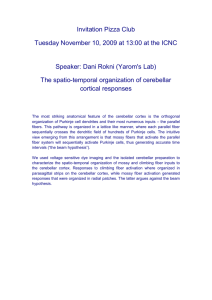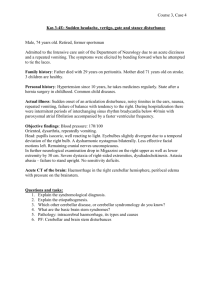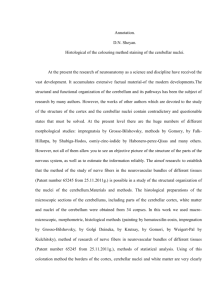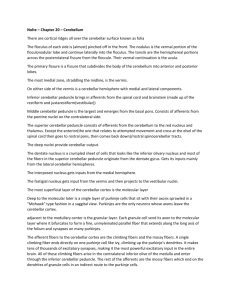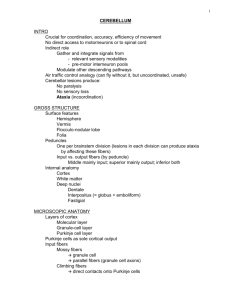9-10 Cerebellum and Pathways - 34-602-Neuroanatomy
advertisement
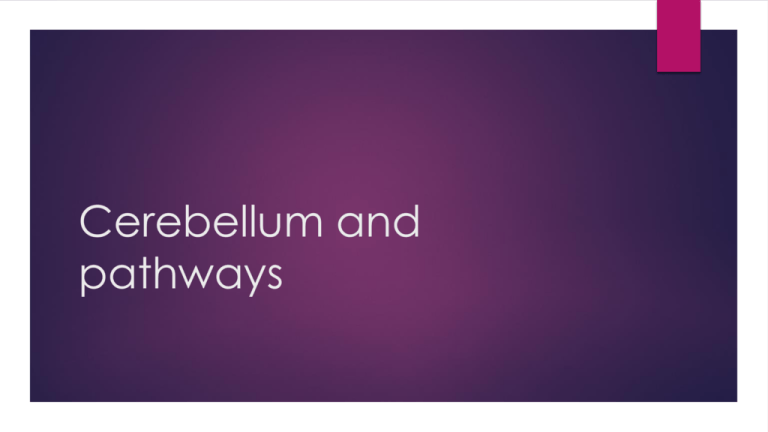
Cerebellum and pathways Objectives - cerebellum Identify the anatomical divisions of the cerebellum Identify the functional divisions of the cerebellum Explain what observable functions each division of the cerebellum is involved with Describe each afferent and efferent pathway – structure, function, neurotransmitters, and neuron type if applicable Describe or draw the layers of the cerebellar cortex Describe or draw the types of neurons in the cerebellar cortex Identify which neurons are excitatory (glutamate & aspartate) and which are inhibitory (GABA) Explain how the neurons in the cerebellar cortex interact Plan of attack Lecture 9 – cerebellar structure and organization, afferent cerebellar pathways, efferent cerebellar pathways Lecture 10 –cerebellar histology, motor learning Overall function Ataxia with intention (action) tremor: Ataxia with gross limb movement dysfunction: https://www.youtube.com/watch?v=FpiEprzObIU Dysmetria: https://www.youtube.com/watch?v=qKGicpQLt6M Ataxic Gait: https://www.youtube.com/watch?v=5eBwn22Bnio https://www.youtube.com/watch?v=jnQcKAYNuyk Dysdiadochokinesia: https://www.youtube.com/watch?v=gNZFSUdL_uc Anatomical structure Gray Cortex! (Folia = sulci and gyri) Floculonodular lobe Anterior lobe Posterior lobe White Matter Cerebellar peduncles -> Arbor Vitae (tree of life!) Deep Nuclei 4 total (per hemisphere) View of entire cortex Functional structure Vestibulocerebellum (floculonodular lobe) Balance during stance/gait, coordinates eye and body movements Associated with vestibular nuclei Spinocerebellum (vermis and paravermis) Coordination of limb movements Associated with spinal cord directly and indirectly Cerebrocerebellum (lateral hemispheres) Planning and preparation for movement, fine motor control Associated closely with motor cortex (pre-central gyrus) Cerebellar nuclei Lateral – Dentate Middle – Interposed; Emboliform and Globose Medial – Fastigial Nuclei connections Fastigial – vestibulocerebellum to vestibular nuclei and eye motor centers Interposed – spinocerebellum to contralateral red nucleus Dentate – cerebrocerebellum to thalamus Rubrospinal tract Planning and control of voluntary movements All cerebellar efferents synapse in the deep nuclei The nodulus connects to which nucleus? 94% 6% De nt at e 0% bo lif or m 0% Em D. e C. Gl ob os B. Fastigial Globose Emboliform Dentate Fa st ig ia l A. Your patient has difficulty with fine motor control. Which nucleus would be associated? 97% 0% De nt at e 0% bo lif or m 3% Em D. e C. Gl ob os B. Fastigial Globose Emboliform Dentate Fa st ig ia l A. Which part of the cerebellum would be associated with the same patient? 100% re br oc er eb el lu m 0% Ce 0% Sp in oc er eb el lu m C. ib ul oc er eb el lu m B. Vestibulocerebellum Spinocerebellum Cerebrocerebellum Ve st A. Cerebellar Afferents 4 Spinocerebellar Tracts Pontocerebellar Reticulocerebellar Raphecerebellar Hypothalamocerebellar Ceruleocerebellar Olivocerebellar Spinocerebellar Tracts (cross-section) Cuneocerebellar Pathway Information ascends in the cuneate tract Synapses in the Accessory cuneate nucleus (lateral to the cuneate nucleus in the medulla) Second neuron ascends ipsilaterally through ICP to cerebellar nuclei and cortex Entire pathway is IPSILATERAL Carries sensory information from UE Posterior Spinocerebellar Pathway Ascends ipsilaterally in PSC tract Synapses in spinal cord Passes through ICP Ends in cerebellar cortex and nuclei Carries sensory information from LE Rostral Spinocerebellar Pathway Ascends ipsilaterally Runs with cuneocerebellar, and then splits and runs with ASC after it crosses Enters cerebellum through SCP (like ASC) Carries sensory information from UE Anterior Spinocerebellar Pathway Ascends contralaterally in ASC tract Crosses through the SCP Ends in ipsilateral cerebellar cortex and nuclei Carries sensory information from LE Which pathway carries sensory information to the cerebellum from the UE and goes through the SCP? 100% 0% tro ce re be lla r 0% Ro s 0% PS C D. la r C. Cu ne oc er eb el B. ASC Cuneocerebellar PSC Rostrocerebellar AS C A. The ICP is damaged. Which of the following is TRUE? in fo fro m ... bo t.. . in fo Co nt ra la te ra ls en so ry en so ry to in fo en so ry Ip sil at er al s 0% fro m th e. .. c.. . th e to in fo D. 0% Co nt ra la te ra ls C. 19% en so ry B. Ipsilateral sensory info to the cerebellum from the UE is completely gone. Contralateral sensory info to the cerebellum from the LE is completely gone. Ipsilateral sensory info from both limbs is reduced. Contralateral sensory info from both limbs is reduced. Ip sil at er al s A. 81% Spinocerebellars Which is the red? Which is the blue? Which is the green? Which is missing and where would it be? All MOSSY FIBERS Other cerebellar afferents Pontocerebellar Reticulocerebellar Raphecerebellar Hypothalamocerebellar Ceruleocerebellar All MOSSY FIBERS Olivocerebellar Pathway Information from Inferior Olivary Nucleus Crosses to the ICP Ends in the cerebellar cortex and nuclei CLIMBING FIBERS Which of the following do NOT connect to the #reticular formation? 49% C. D. E. 5% 0% 2% ru le oc er eb el la r Po nt oc er eb el la r Ra ph ec er eb el la Re r tic ul oc er Hy eb po el la th r al am oc er eb el la r B. Ceruleocerebellar Pontocerebellar Raphecerebellar Reticulocerebellar Hypothalamocerebellar Ce A. 44% Cerebellar afferent Drawing! Split the 4 spinocerebellars into 2 groups – draw 2 pathways per image Either by LE vs. UE, or by similar pathways (Cuneo and Post., Rostral and Ant.) Draw olivocerebellar tracts Add essential information to each drawing along the side: Where does the pathway decussate (if it does)? Which cerebellar peduncle does it go through? What information does it carry? What type of fibers is it? (mossy or climbing) Cerebellar efferents Corticonuclear Nucleocortical Corticovestibular Other efferents Cerebellar Corticonuclear Pathway “Fibers” LC = Lateral Cortex Cerebellar cortex (Purkinje cells) → cerebellar nuclei Cerebellar Nucleocortical Pathway “Fibers” Cerebellar nuclei neurons (Nuclei Cells) → cerebellar White Matter = Arbor Vitae IC = Intermediat e Cortex VC = Verma l Cortex Cerebellar Corticovestibular Pathway o Starts in: Purkinje cells within vermis, nodulus, & focculonodular lobe (Cerebellar Cortex) o Through Inferior Cerebellar Peduncle o Ends in: Vestibular nuclei within the brainstem All of the neurons with somas in the deep cerebellar nuclei exit the cerebellum. 91% A. True B. False Fa lse Tr ue 9% The corticovestibular tract is from the cerebellar cortex directly to the vestibular nuclei. 97% A. True B. False Fa lse Tr ue 3% Conclusion Read for Wednesday L-E ch. 11 pt. 1 We will discuss cerebellar histology Wed. and talk about how the plasticity plays a role a motor learning! Nuclear Efferents Dentate and Interposed nuclei Neurons cross in SCP Go to Thalamus, Pontine nuclei, Reticular formation, Red nucleus, Olivary bodies, Oculomotor complex (nystagmus) From thalamus up to cerebral cortex From other structures, straight down the spinal cord Cerebellar Efferent Fibers & Motor Control 1. Cerebellorubral route connects the rubrospinal route • cerebellum → red nucleus → SC 2. Cerebelloreticular route connects the reticulospinal route • cerebellum → reticular formation → SC 3. Cerebellothalamic route connects the thalamocortical route Which then connects to the corticospinal route • cerebellum → thalamus → cortex → SC *Cerebellar nuclei influence motor control Takeaways – cerebellar efferents All efferents from cerebellar nuclei (Dentate, Interposed, Fastigial) Fastigial goes to vestibular nuclei Bilateral Dentate and interposed go to thalamus, red nucleus, pontine nuclei, olivary nuclei, and #RF All decussate in SCP All decussate again to go down spinal cord All information ends up being IPSILATERAL Which of the following are bilateral tracts? 0% 0% tro sp in oc er eb el la r Co rt ico ve st ib ul ar 0% la r 0% Ro s Ol iv oc er eb el D. la r C. oc er eb el B. Hypothalamocerebellar Olivocerebellar Rostrospinocerebellar Corticovestibular Hy po th al am A. Objectives - cerebellum Identify the anatomical divisions of the cerebellum Identify the functional divisions of the cerebellum Explain what observable functions each division of the cerebellum is involved with Describe each afferent and efferent pathway – structure, function, neurotransmitters, and neuron type if applicable Describe or draw the layers of the cerebellar cortex Describe or draw the types of neurons in the cerebellar cortex Identify which neurons are excitatory (glutamate & aspartate) and which are inhibitory (GABA) Explain how the neurons in the cerebellar cortex interact Histology! Cerebellar cortex histology, once understood, gives a really awesome and essential understanding to motor learning! 3 layers of cerebellar cortex Molecular (outer) layer Purkinje layer Granular (inner) layer Zoomed in! Reference: White area is air – outside the folia (a sulcus) Notice: molecular layer, purkinje cells, granular layer Molecular layer Parallel fibers (axons of granular cells, telephone wires) Climbing Fibers (like vines on the purkinje tree) Dendrites of purkinje cells (tree like) Basket and Stellate cells Purkinje layer Purkinje somata Granular layer Granule somata Golgi cells Zoomed in! Reference: White area is air – outside the folia (a sulcus) Notice: molecular layer, purkinje cells, granular layer Afferent fibers Information coming IN!! Climbing Fibers (vines) Mossy Fibers (stimulate granule cells) Mossy fibers (afferent pathways) Come from all afferent pathways except olivocerebellar List them! Excite granular cells (parallel fibers, telephone wires) with high frequency, weak EPSP glutamate Bring in information constantly on what’s planned and what’s actually happening with somatic motor control Like the internet, all information is transmitted through telephone cable system Climbing fibers (olivocerebellar) Powerful excitation to purkinje cells (vines on purkinje tree) glutamate Respond to interruptions in balance (from reflexes in spinal cord) Olivocerebellar Only fire when an immediate reaction is required! Like the CIA when something important is found on the internet! Granule cells Granule cells (parallel fibers in molecular layer) Telephone wires All run parallel, highly structured in cortex Granule cells Soma is in granular layer Axon ascends to molecular layer, splits, and runs as parallel fiber Excitatory but weak to purkinje cells – requires multiple action potentials to break threshold glutamate Purkinje neurons Named after one of the first neuroscientists Main efferent neurons (cortex to deep cerebellar nuclei) Have a huge dendritic tree in the molecular layer Are acted on by: Parallel fibers Climbing fibers Efferent fibers Purkinje neurons (inhibitory) GABA Giant dendritic tree Weak but frequent stimulation from granule cells Strong but infrequent stimulation from climbing fibers Which pathways? Which pathways? Inhibit deep nuclei (DEGF) Inhibitory interneurons Basket cells Inhibit purkinje cells Golgi cells Inhibit granule cells All GABA Basket cells Axon terminals wrap around purkinje cell bodies like baskets Inhibit purkinje cells GABA Excited by parallel fibers Golgi cells Inhibit granule cells GABA Located in granular layer Excited by parallel fibers Task In your team, create a short video (with phones or other devices) explaining how information enters the cerebellum, how the neurons interact, and how the information is sent out of the cerebellum. Include: Mossy fibers and pathways that fall into this category Climbing fibers and pathway(s) that fall into this category Granule cells with parallel fibers Purkinje cells Corticonuclear and nucleocortical tracts Excitation vs inhibition (and neurotransmitters) Today in class: create a plan, write up a script Post a link to your video on the wiki by Friday Sunday midnight. (part of participation grade – out of 10 points) Wiki page: Cerebellar Histology Videos (available through term lists and images) Reciprocal Inhibition Interneurons inhibit purkinje and granule cells Only excitation comes from mossy and climbing fibers Result is inhibitory outputs Motor learning and the cerebellum Theory: When climbing fiber input and parallel fiber input occur at the same time on the purkinje cell, the post-synaptic purkinje dendrite experiences long-term depression (LTD) Beyond this is yet unknown but studying the cerebellar cortex has surfaced these three hypotheses: Learning and memory can result from modifications of synaptic transmission. Synaptic modifications can be triggered by the conversion of neural activity into intracellular second messengers. Memories can result from alterations in existing synaptic proteins. Cerebellum Overview Functional structure Vestibulocerebellum Spinocerebellum Cerebrocerebellum Pathways Afferents Efferents Cerebellar histology Neuron types Organization of the Course Spinal Cord Brainstem/ Cerebellum Sensory Pathways Overview and Development Other Pieces of the puzzle Cerebrum Cranial Nerves Motor Pathways Exam formats Midterm: 60 MC Mix of know, understand, apply questions Tag Test: 15 stations, 5 questions per station = 75 questions New format: 3-2-1 done Lab closes end of day Wednesday March 4 Conclusion Start discussing the rest of the sensory pathways Monday! Assignment #2 due Monday Only 3 lectures left until Midterm Exam!! Finish creating video, post to wiki by Friday midnight!
